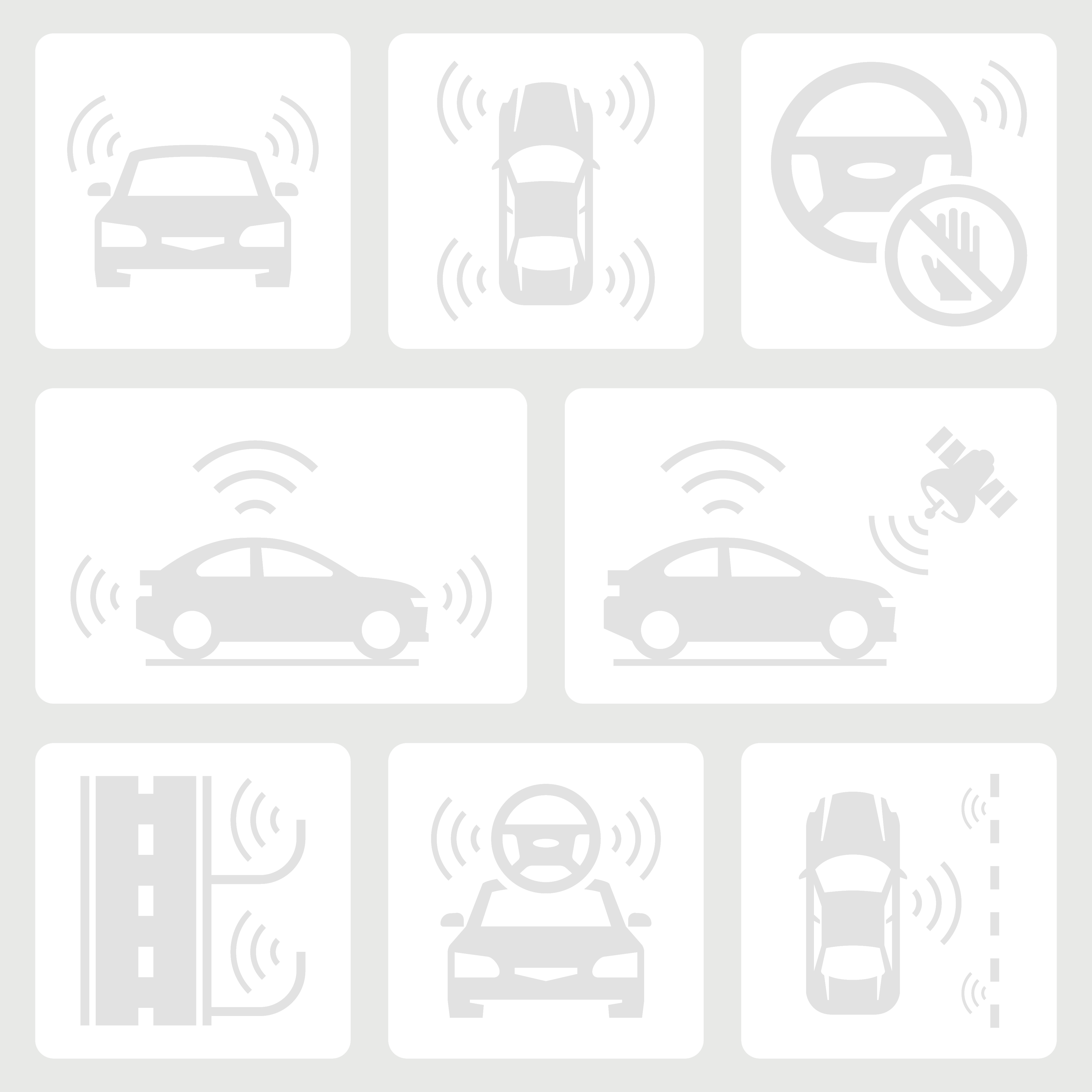report | Almost Autonomous: putting semi self-driving cars on the road
November 14, 2018

— contents —
~ story
~ report
~ reading
~ key points
— the story —
Many automated safe driving technologies — that use on-board computers, sensors, robotic controls for steering, braking, maneuvering — are now available in non-luxury vehicles. The automobile industry calls these advanced semi-automated technologies “driver assistance suites.” Outfitted in everyday vehicles — light-weight: cars + vans + trucks — these automatic, computerized features can prevent major loss of life, disability, and property damage stemming from 1 million accidents yearly in the US.
This interesting research report showcases the rapid progress of high-tech computers, sensors, and robotics in vehicles available today to the public — at reasonable prices.
— the report —
institute: Carnegie Mellon Univ.
research group: Traffic 21 — An institute for smart transportation research.
report: Cost + Benefit
deck: Estimates of partially-automated vehicle collision avoidance technologies.
journal: Accident Analysis + Prevention
publisher: Elsevier
year: 2016
The here + now of smart vehicles.
The researchers said there’s a lot of discussion about driver-less vehicles. So self-driving cars are fancy, futuristic, complex — and get heaps of attention on television, in magazines, and in the news. Their concern is that until the world-wide installation of totally self-driving transport happens — we should focus on near-term solutions that are already with us: partially-automated cars, vans, trucks.
The report highlights the costs for equipping vehicles with driving-assist features — vs. — how much money can be saved by avoiding accidents in the first place. Their conclusion is: it’s worth it. The researchers list clear evidence: even with partial automation, there are big financial and safety benefits.
This report can support: business strategy, tactical ideas for fleet management, insurance planning, and personal shopping for a safer car or truck. What’s surprising about this report is the wide range of choices now available for smart vehicles. Many luxury and mid-level sedans come equipped with complex safety measures.
We can’t always see how much amazing technology is built into new cars — already at our finger-tips. Most publications note that today’s vehicles are fully loaded with an average of 30 to 100 on-board mini-computers: called micro-processor control devices — aka — electronic control units.
That’s an astounding amount of progress in automating our driving experience since the 1970s. Modern times are also fast times, and the always-growing global population means every day more people enter the urban and rural road systems. Extreme weather also seems to be more common. It’s a good time to explore your high-tech options for driver assist features, now at affordable prices to the general public.
This report from Carnegie Mellon University’s contemporary Traffic 21 institute shows the benefits in actual numbers + trends. There are also some good reference lists below, presented in a way that’s slim and easy to understand. We hope you find this folio helpful and interesting.

on the web | pages
Carnegie Mellon Univ. | home
Carnegie Mellon Univ. | Traffic 21: home
Carnegie Mellon Univ. | Traffic 21: blog
on the web | reading
the Driving Machine | How many computers are in a car today?
deck: Electronic control units keep you safe + your vehicle operating properly.
USA Today | Your average car is a lot more code-driven than you think
deck: Today’s cars consist of an extremely complex set of sub-systems.
AAMCO | Computers in your car
deck: Computerization has revolutionized how cars work, how they are made + how we view them.
Wired | Self-driving cars use crazy amounts of power, and it’s becoming a problem
deck: Companies pursuing same goals to develop low-power chips + efficient hardware.

— key points —
Prevention now.
Notes from the report:
A. | the report says if we deploy semi-automated driving (all the time, everywhere it’s possible) in vehicles now, we can:
- prevent or reduce the severity of 1.3 million vehicle accidents — yearly in US
- prevent or reduce the severity of 133,000 injury crashes — yearly in US
- prevent 10,100 fatal vehicle accidents — yearly in US
B. | the US National Highway Traffic Safety Administration said:
The US government will not abandon efforts to speed the development of self-driving cars, to reduce the 94% of car crashes attributed to human operator error, despite some serious accidents with recent vehicles using an auto-pilot system. But autonomous vehicles should be much safer than human drivers before they’re deployed on US roads.
with material from: Reuters
C. | a practical, temporary solution
Today’s high-tech, partially-automated, vehicle crash avoidance features are: a practical, temporary solution for safer driving — until fully autonomous vehicles can be made-ready for the public.
Driver assist features can switch the car: from human operator — to computer operated in the seconds when a accident can happen. When automated systems take over, or alert the driver to hidden dangers, we can better navigate the complex traffic and terrain of highways + surface streets in modern cities.
D. | saving lives, saving money
Many cars are equipped with these advanced features, and they can make a big difference on the road. Driver assist features save lives, save money — and the government + automobile manufacturers should push to install them in our cars, buses, vans and trucks.
driver assist features — made of computer, robotic, sensing technologies:
- forward collision warning
- forward collision avoidance
- lane departure warning
- blind spot monitoring
- partially automated braking
- partially automated steering
- parking assist
- gear shift assist
- headlamps: with auto-dimming + auto-brightening
- headlamps: with auto-positioning
- interior sound system: auto-dimming + auto-brightening
- interior rear-view mirror: auto-dimming + auto-brightening
- low tire: pressure sensor
- low tire: alert
- automatic rain + snow detection
- automatic wind-shield wipers
- automatic pedestrian detection
- automatic object + animal detection
- automatic anti-lock breaks
- touch-screen digital map navigation — alerts in natural speech
- seat belt + engine service warnings — alerts in natural speech
- door ajar + child lock warnings — alerts in natural speech
- smart cruise control
- smart anti-skid
- smart anti-lock brakes
- enabled human voice controls — spoken by driver
- enabled human voice styled alerts — spoken by on-board features
E. | in a nut-shell
- report compared the price of: equipping cars with safety tech — vs. — yearly money saved if crashes don’t happen.
- for reference, they used data from: government agencies+ insurance industry.
- they discovered that even with the installation costs, having driver assist technology in the vehicle pays off.
- there are also life-saving benefits.
- in a perfect-world scenario — where all crashes of this kind are avoided by using driver assist tech.
- in a perfect-world scenario — there’s a yearly savings of $202 billion or $861 per car.
F. | key points from the report
- many light-duty vehicles crash because of human operator mistakes + distracted driving.
- partially-automated crash avoidance tech can reduce frequency, severity of these accidents.
- partially-automated crash avoidance tech can help keep control of the vehicle.
- state-of-the-art danger detection + alert features can keep accidents from happening at all.
- there are benefits + costs with fleet-wide deployment of these kinds of safety features.
- tech always gets better over time.
- lower prices will lead to larger net benefits over time.
- so the cost of tech reduces in large-scale economies and with better functionality.
- partially-autonomous crash avoidance features: could save $18 billion yearly — for light-duty vehicles.
- total annual costs to equip light-duty vehicles — are still less than the savings from avoided crashes.

by definition | What is a light-duty vehicle?
A light-duty vehicles is any motor vehicle with a gross weight rating of 10,000 pounds or less. This category includes everyday passenger cars like sedans, wagons, coupes, hatch-backs. It also includes sport utility vehicles, and light-weight pick-up trucks — but it doesn’t include heavy-weight trucks.
The term gross weight rating is the maximum operating weight of a vehicle as specified by its manufacturer including: the vehicle’s chassis, body, engine, fluids, fuel, accessories, driver, passengers and cargo — but doesn’t include the added weight of trailers.
video no. 1 | The levels of self-driving vehicles explained.
Guide to the chart.
The Society of Automotive Engineers uses 0-to-5 different levels to describe the extent a car is self-driving — but what’s the point of this system, and what are the differences between the levels? Autonomous cars are also called self-driving cars. But not all autonomous cars are fully self-driving. The level of autonomous driving is dependent on the amount of computerized + robotic automatic features built-in. Take a look at the 0-to-5 levels of autonomous cars.
- level 0 — no automation
- level 1 — driver assistance
- level 2 — partial automation
- level 3 — conditional automation
- level 4 — high level automation
- level 5 — complete automation
description by: Tech Quickie
by definition | What is a partially-automated vehicle — vs. — a fully-automated vehicle.
A partially-automated car or truck has tech built-in that can: scan for, detect, and warn you about dangerous roadway and collision hazards like obstructions, out-of-control vehicles near-by, and sudden debris or pedestrians. These types of features are designed to assist you as driver, but not completely take-over your vehicle. In tight situations the features are equipped to take-over your steering, braking or parking: but it’s only until that need has passed. Then the controls are handed back to you, the human operator.
By comparison, fully-automated vehicles are equipped with advanced sensors that can: scan the roadways, environmental + climate conditions, terrain, distance, objects + animals + pedestrians, street signs, highway markings, pavement + curbs. Using an on-board computer that makes all the driving decisions — the vehicle safely navigates without any human operator. The vehicle could be a sedan, bus, truck, boat — it can park, avoid a collision, predict obstacles, and manage loss of control.
So the primary difference between partially-automated and fully-automated vehicles: is a complete ability for the car to drive itself, while you can sit-back. Autonomous is a word that means totally automatic: it deals with robotic machines that use computers to move, sense, do activities, and calculate information — without the help of any human. The highways + byways of the globe are being made ready for the arrival of totally self-driving vehicles — everywhere.

— funding for this research project —
the National Science Foundation | home
the Hillman Foundation | home
on the web | reading
Insurance Quotes | Object detection technology now in cars
deck: A second pair of 20/20 eyes in your vehicle.
Road Show by cNet | Self-Driving Cars: a level-by-level explainer of autonomous vehicles
deck: Your guide to understanding the road to self-driving vehicles, as defined by the Society of Automotive Engineers
on the web | pages
Elsevier | home
Elsevier | welcome video

